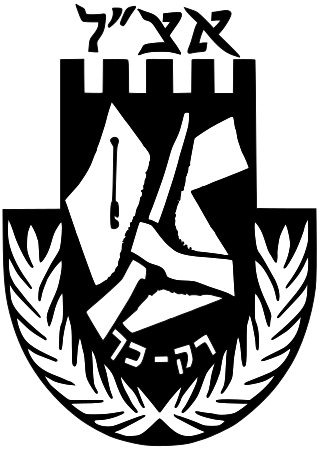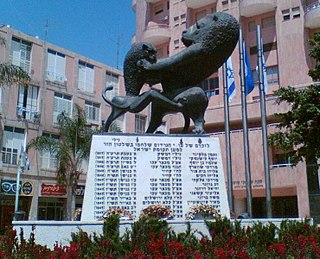
The Irgun, or Etzel, was a Zionist paramilitary organization that operated in Mandatory Palestine between 1931 and 1948. It was an offshoot of the older and larger Jewish paramilitary organization Haganah. The Irgun has been viewed as a terrorist organization or organization which carried out terrorist acts.

Zionist political violence refers to acts of violence or terrorism committed by Zionists in support of establishing and maintaining a Jewish state in Palestine. These actions have been carried out by individuals, paramilitary groups, and the Israeli government, from the early 20th century to the present day, as part of the ongoing Israeli-Palestinian conflict.
Haganah was the main Zionist paramilitary organization that operated for the Yishuv in the British Mandate for Palestine. It was founded in 1920 to defend the Yishuv's presence in the region, and was formally disbanded in 1948, when it became the core force integrated into the Israel Defense Forces shortly after the Israeli Declaration of Independence.

A popular uprising by Palestinian Arabs in Mandatory Palestine against the British administration of the Palestine Mandate, later known as The Great Revolt or The Great Palestinian Revolt, or the Palestinian Revolution, lasted from 1936 until 1939. The movement sought independence from British colonial rule and the end of the British authorities' support for Zionism, which sought the establishment of a Jewish state in Palestine by means of mass migration and displacement of the local Arab population.

Yishuv, HaYishuv HaIvri, or HaYishuv HaYehudi Be'Eretz Yisra'el denotes the body of Jewish residents in Palestine prior to the establishment of the State of Israel in 1948. The term came into use in the 1880s, when there were about 25,000 Jews living in that region, and continued to be used until 1948, by which time there were some 630,000 Jews there. The term is still in use to denote the pre-1948 Jewish residents in Palestine, corresponding to the southern part of Ottoman Syria until 1918, OETA South in 1917–1920, and Mandatory Palestine in 1920–1948.

The Betar Movement, also spelled Beitar (בית"ר), is a Revisionist Zionist youth movement founded in 1923 in Riga, Latvia, by Vladimir (Ze'ev) Jabotinsky. It was one of several right-wing youth movements that arose at that time and adopted special salutes and uniforms influenced by fascism.

Revisionist Zionism is a form of Zionism characterized by territorial maximalism. Revisionist Zionism promoted expansionism and the establishment of a Jewish majority on both sides of the Jordan River.

David Raziel was a leader of the Zionist underground in British Mandatory Palestine and one of the founders of the Irgun.

The White Paper of 1939 was a policy paper issued by the British government, led by Neville Chamberlain, in response to the 1936–1939 Arab revolt in Palestine. After its formal approval in the House of Commons on 23 May 1939, it acted as the governing policy for Mandatory Palestine from 1939 to the 1948 British departure. After the war, the Mandate was referred to the United Nations.

Shlomo Ben-Yosef was a member of the Revisionist Zionist underground group Irgun. He is most noted for his participation in an April 21, 1938, attack on a bus carrying Arab civilians, intended as a retaliation for an earlier attack by Arabs against Jews, and emblematic as a rejection of the establishment policy of Havlagah, or restraint. For this reason, and especially for having been the first Jew executed by the British authorities during the mandate period, Ben-Yosef became a martyr for the Revisionist cause and is commemorated by the State of Israel as one of 12 Olei Hagardom.

Havlagah was the strategic policy of the Yishuv during the 1936–1939 Arab revolt in Palestine. It called for Zionist militants to abstain from engaging in acts of retaliatory violence against Palestinian Arabs in the face of Arab attacks against Zionist Jews, and instead encouraged the Jewish community to respond to the attacks through non-violent means, such as by fortifying their settlements. The policy was supported by the Yishuv's political leadership and many left-wing Zionists. It was adopted by Haganah, the main Zionist paramilitary in Mandate Palestine, as an official operational strategy. On the other hand, Irgun, Lehi, and other like-minded Zionist paramilitaries rejected the policy and engaged in indiscriminate violence against the Arab community.

Olei Hagardom refers to members of the two Jewish Revisionist pre-state underground organisations Irgun and Lehi, most of whom were tried in British Mandate military courts and sentenced to death by hanging. Most of the executions were carried out at Acre Prison. There were 12 Olei Hagardom.
The Palestinian people are an ethnonational group with family origins in the region of Palestine. Since 1964, they have been referred to as Palestinians, but before that they were usually referred to as Palestinian Arabs. During the period of the British Mandate, the term Palestinian was also used to describe the Jewish community living in Palestine.

During the British rule in Mandatory Palestine, there was civil, political and armed struggle between Palestinian Arabs and the Jewish Yishuv, beginning from the violent spillover of the Franco-Syrian War in 1920 and until the onset of the 1948 Arab–Israeli War. The conflict shifted from sectarian clashes in the 1920s and early 1930s to an armed Arab Rebellion against British rule in 1936, armed Jewish Revolt primarily against the British in mid-1940s and finally open war in November 1947 between Arabs and Jews.

A successful paramilitary campaign, sometimes referred to as the Palestine Emergency, was carried out by Zionist underground groups against British rule in Mandatory Palestine from 1944 to 1948. The tensions between the Zionist underground and the British mandatory authorities rose from 1938 and intensified with the publication of the White Paper of 1939. The Paper outlined new government policies to place further restrictions on Jewish immigration and land purchases, and declared the intention of giving independence to Palestine, with an Arab majority, within ten years. Though World War II brought relative calm, tensions again escalated into an armed struggle towards the end of the war, when it became clear that the Axis powers were close to defeat.

The Deir Yassin massacre took place on April 9, 1948, when Zionist paramilitaries attacked the village of Deir Yassin near Jerusalem, Mandatory Palestine, killing at least 107 Palestinian villagers, including women and children. The attack was conducted primarily by the Irgun and Lehi, who were supported by the Haganah and Palmach. The massacre was carried out despite the village having agreed to a non-aggression pact. It occurred during the 1947-1948 civil war and was a central component of the Nakba and the 1948 Palestinian expulsion and flight.
Operation Hametz was a Zionist operation towards the end of Mandatory Palestine, as part of the 1948 Palestine war. It was launched at the end of April 1948 with the objective of capturing villages inland from Jaffa and establishing a blockade around the town. The operation, which led to the first direct battle between the British and the Irgun, was seen as a great victory for the latter, and enabled the Irgun to take credit for the complete conquest of Jaffa that happened on May 13.

Mandatory Palestine was a geopolitical entity that existed between 1920 and 1948 in the region of Palestine under the terms of the League of Nations Mandate for Palestine.
This is a timeline of intercommunal conflict in Mandatory Palestine.

The 1948 Palestine war was fought in the territory of what had been, at the start of the war, British-ruled Mandatory Palestine. During the war, the British withdrew from Palestine, Zionist forces conquered territory and established the State of Israel, and over 700,000 Palestinians fled or were expelled. It was the first war of the Israeli–Palestinian conflict and the broader Arab–Israeli conflict.















